on all orders over $100
on all orders over $100
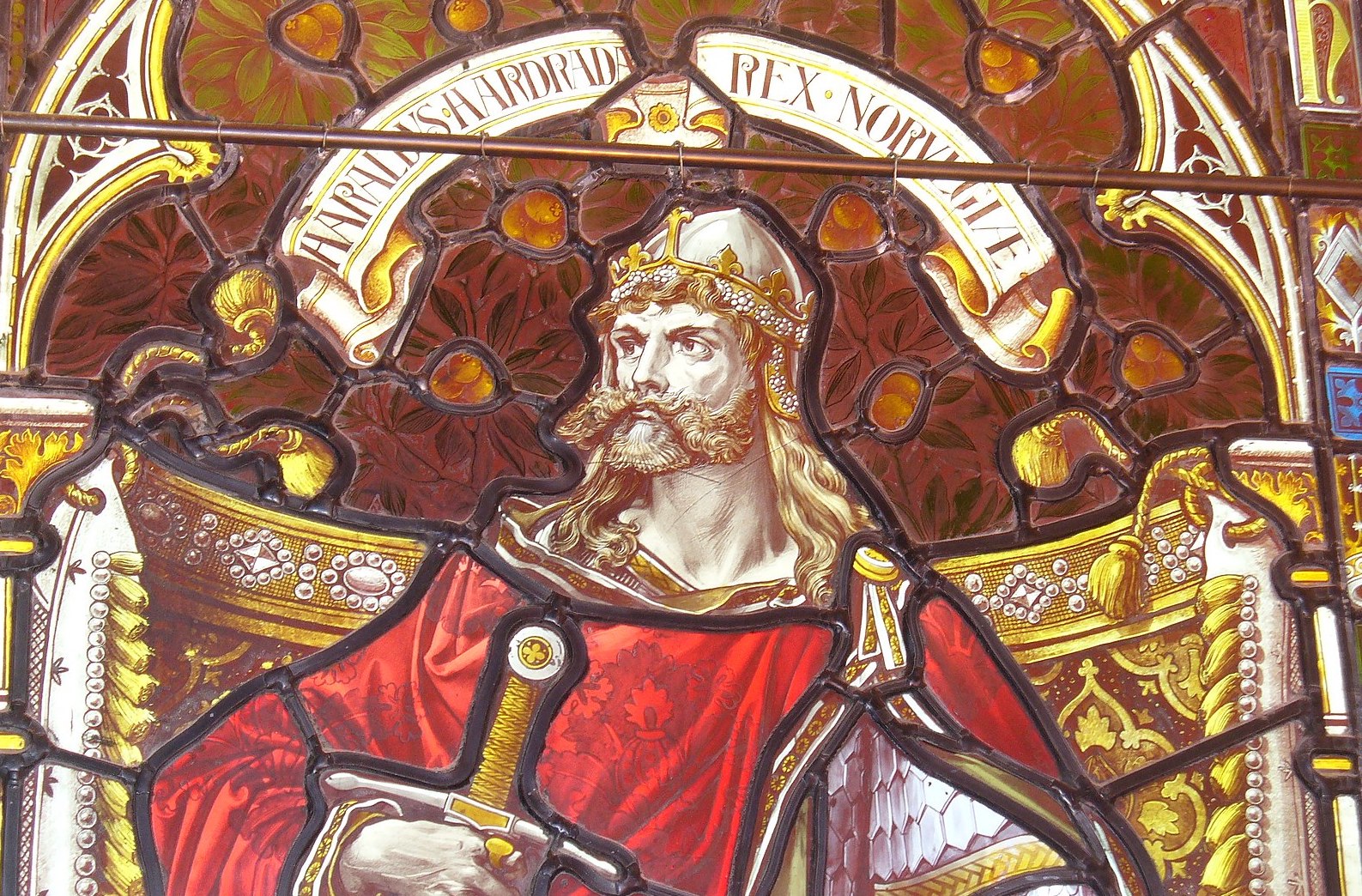
History remembers the Vikings as fierce warriors and pioneers who lead raids throughout northern Europe in the 9th and 10th Century AD. The norsemen respected strength and bravery therefore being a viking leader was no easy task.
From leading raids on the British Isles and Northern France to sailing into uncharted waters in some of the worlds most dangerous oceans, many of the Vikings exploits were not for the faint hearted. It is not surprising therefore that amongst the leaders of the Vikings there are some intriguing and unusual characters.
Here are our top 10 picks for the most famous Viking Warriors you should know about:
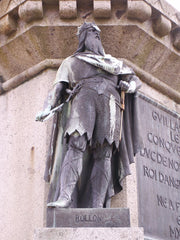
Statue of Rollo in Falaise Square - Wikimedia Commons
1. Rollo of Normandy
The first Viking king of Normandy in northern France, Rollo was one of the few men who really left his mark on history. He is thought to have been born in either Norway or Denmark and began raids into France in the 9th century. In 911AD he signed the treaty of St. Claire-sur-Epte with the Frankish King Charles which gave Rollo and his men rights to settle in Normandy (Northman's Land). Part of the deal was that Rollo would help defend them from any future Viking raids.
Rollo continued to grow in power and increased his influence in the region until his death in 928AD where he was succeeded by his son William Longsword. This was the start of the Norman peoples, who had a profound impact on European history. His descendant, William of Normandy, later known as William the Conqueror went on to become the first Norman king of England.
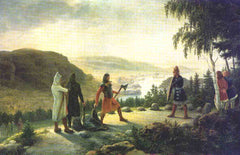
Picture of Egil Skallagrimsson in holmgang against Berg-Önundr - Johannes Flintoe
2. Egil Skallagrimsson
Egil was a complex man, featuring in many Norse sagas he was noted as being prone to violent outbursts, yet also produced beautiful poetry. Many of his poems are considered to be amongst the finest to come out of ancient Scandinavia.
He killed for the first time at the age of 7, when he ha d a quarrel with another boy and ended up murdering him with an axe. Most of his adult life was spent pillaging and plundering from his home in 10th century Iceland.
Egil began a long term feud when he killed a friend of King Erik Bloodaxe. Engraged, the king sent more men to try to kill Egil, including the king's own son. However Egil was an accomplished warrior and showed his skill by defeating each and every man who was sent. When he was eventually captured and taken to the king it is said that he wrote a masterful poem, which impressed Erik so much that he decided to spare his life.

Ragnar and Aslaug picture - August Malmström
3. Ragnar Lothbrok
Recently made popular in TV show 'Vikings' Ragnar Lothbrok has long been considered one of the most influential figures in Norse sagas. He fathered many sons with different women, including; Bjorn Ironside, Ivar the Boneless, Halfdan Ragnarsson, Sigurd Snake-in-the-eye, and Ubbe Ragnarsson, Many of whom went on to be notorious Viking leaders in their own right.
Most of his life was spend raiding France and the East of England, where he frequently pillaged with hordes of men on Longships. At one point he was offered 7,000 lbs of silver by a Frankish King Charles if he agreed not to attack Paris.
He finally met his end when he attempted to invade England with just two ships and was shipwrecked on the coast. He was subsequently captured and killed by being thrown into a pit of vipers. His sons then lead the great heathen army in an invasion into England in order to avenge the death of their father.

14th Century painting of Cnut the Great
4. Cnut the Great
The son of the great Danish king Svein Forkbeard, Cnut was the first danish king of England. He conquered England in 1013 with his father. After Sveins death he won at the battle of Ashingdon and signed a treaty with Kind Edmund Ironside to give him power over part of England. A few weeks later Edmund died and Cnut became ruler of all the country.
His reign was one of peace and stability after years of seemingly endless battles. Denmark, Norway and parts of Sweden all became part of his great empire and Danish law lasted in England until his son Harthacnut died in 1042.
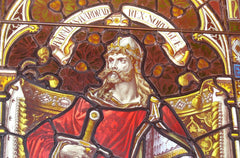
Photo of church window of Harald - Colin Smith
5. Harald Hardrada
Harald Hardrada is widely considered to be the last of the Viking warrior kings of Scandinavia. His name translates from the old norse for 'hard ruler'. As a young man, no more than 15 years old, he fought alongside his half brother Olaf Haraldsson in the battle of Stiklestad. They were defeated in battle and after Olaf was killed Harald was banished. He spent a short time in Kiev where he worked as a mercenary before arriving in Constantinople which was then part of the Byzantine Empire and serving as part of the Prestigious Varangian Guard.
Harald gained wealth and notoriety as a skilled military commander before returning to his home of Scandinavia. On his return he became co-ruler of Norway with Magnus the good, however Magnus died shortly after giving him full control. There was a long feud between Harald and Svein Estrithson who was king of Denmark at the time. They fought for years before Harald finally decided to give up his claim to the Danish throne and turn his gaze on the English.
Harald invaded England in 1066 and won at the battle of Fulford Gate. He then met the army of the new English king, Harold Godwinson at the battle of Stamford Bridge and was defeated. His death marked the end to the age of great Viking warrior kings. Harold Godwinson was then killed in the battle of Hastings shortly after against the invading force of William the Conqueror, who was a descendant of Rollo.
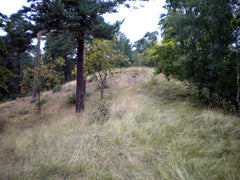
Burial site of Bjorn Ironside - Wikimedia Commons
6. Bjorn Ironside
A fierce warrior and son of Ragnar, Bjorn Ironside became famous in the 9th century for leading many raids into Southern Europe, France, Spain and even as far as Gibraltar and Sicily.
Bjorn and his men were rumoured to have made a daring capture of the town of Luna where he allegedly pretended to be dead in order to be taken inside the town. Once he was taken inside the church he jumped out of the coffin and fought his way to the gates where he opened them and let his men inside.
He continued to raid to many years until he was eventually defeated at sea in the straits of Gibraltar, losing over 40 ships. After returning to Scandinavia he lived the rest of his days in wealth and comfort as King of Sweden.

A picture of Erik the Red - Wikimedia Commons
7. Erik the Red
Erik the Red was a ruthless and fierce man, nicknamed 'Red' for his red hair, violent temper and skill as a warrior. After his father was kicked out of Norway for killing a man he moved to Iceland with his family to settle there, This set the precedent for Erik's life.
After killing several men he himself was kicked out of Iceland for 3 years, he then sailed to Greenland and spent his time exploring. Once his exile had finished he returned to Iceland and recruited around 500 men to go back to Greenland and start the first Norse colony there in 986AD. He named the island Greenland in order to entice settlers, however it is rumoured only 14 of the 25 ships which attempted thee perilous journey made it to their destination.
Erik spent the remainder of his days in Greenland where he fathered 4 children, one of his sons being the famous Leif Erikson and his only daughter Freydís Eiríksdóttir.
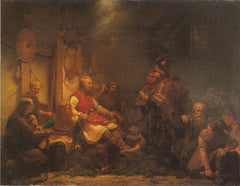
King Ælla explaining to Ivar how his father died - August Malmström
8. Ivar the boneless
Ivar was another son of Ragnar who went on to achieve great fame an notoriety for his raids in England. He lead the great heathen army into battle along with his brother halfdan Ragnarsson and captured the city of York, where they famously killed king Edmund. The wars to avenge the death of his father lasted for around 14 years.
Ivar got his nickname from the fact that he was born with a medical condition which meant his bones fractured more easily, this only makes his reputation as a great warrior even more impressive. Finally Ivar settled in Dublin where he ruled as king of all of the Norsemen in Ireland and the British Isles.
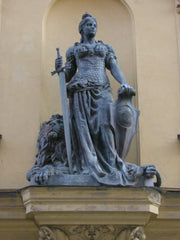
Statue of Freydís Eiríksdóttir in Reykjavík - Wikimedia Commons
9. Freydís Eiríksdóttir
Freydís is proof that Viking women were not to be messed with. She was the daughter of the notorious Viking Erik the Red. A notorious shield maiden and skilled warrior she was famous for sailing to North America and being part of the short lived norse colony there along with her half brother, Leif Erikson. In one account she is said to have single handedly fought off an attack from the natives, all whilst being pregnant.
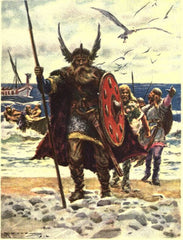
Leif Erikson arriving in North America - Henrietta Elizabeth Marshall, 1976
10. Leif Erikson
A semi-known figure in North America, Leif Erikson was actually the first European to set foot on the American continent, a whole 500 years before Columbus. He was born in 970AD, to the aforementioned Erik the Red. He continued his fathers passion for adventure and sailed into the unknown to find a mysterious new land that was seen by Bjarni Herjolfsson, who's ship was blown off course on the way to Greenland.
Leif and his men started a small settlement in what is thought to be Newfoundland. They called it 'Vinland' due to the grapes and berries which could be found there. He later returned to Greenland with timber from the new world and remained there until his death. The Norse settlement in North America was short lived, which is thought to be due to the hostilities from native tribes.
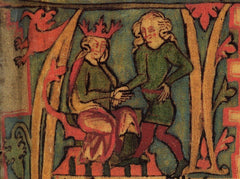
Illustration of Harald - 14th century bookFlateyjarbók
11. Harald Fairhair
Harald Fairhair also known as Harald Finehair is remembered as the first king of all Norway. He reigned from 872AD to 930AD. He is one of the rare viking warriors on this list who did not die a violent death and actually died from old age at the age of 80. He fathered over 20 sons, including notable viking Kings such as Erik Bloodaxe and Haakon the good. The accuracy and even the existence of Harald Fairhair is brought into doubt due to the fact that many of the accounts of his life were only written down in Iceland around 300 years after his death.
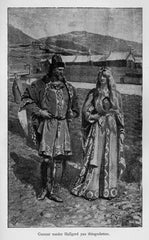
Gunnar meets his future wife Hallgerðr Höskuldsdóttir - Andreas Bloch
12. Gunnar Hamundarson
An Icelandic viking chief who was famous for his physical prowess, good looks and ability as a warrior, he was said to be able to jump his own height, whilst wearing his full suit of armour. He lived during the 10th century AD and he distinguished himself from other famous vikings by favouring to fight using a 'Atgeir' which is a norse pole weapon similar to a halberd. He was also said to be a skilled archer and stone thrower. Gunnar was finally stopped when he killed two men from the same family. Instead of fleeing he remained in his home. A long fight ensued and Gunnar was eventually killed.
Thanks for reading and learning more about our Norse forefathers. If you enjoyed our article or if you have anything to add please leave a comment.
Check out some of our handmade Viking Axes.
Leave a comment